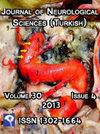Activity of facial and swallowing muscles during water and sour bolus deglutition in healthy adult humans
Q Medicine
引用次数: 1
Abstract
There are very close relationships among deglutition, taste sensations, and facial expressions in humans. However, the associations among mimicking, swallowing, and the suprahyoid/submental muscle group (SM) during deglutition events have yet to be investigated using electrophysiological techniques to elucidate taste sensation and facial expression further. Thus, this study used surface EMG to evaluate synchronous electromyography activity in the facial and swallowing muscles during the swallowing of water and sour boluses in 20 normal healthy adults. All participants were instructed to swallow four bolus volumes (5, 10, 15, and 20 ml) each of a water bolus and a sour bolus (lemon juice) in a neutral head position. EMG recordings were obtained from the orbicularis oculi (OC; a mimic muscle), orbicularis oris (OR; a mimic and swallowing muscle), and SM (deglutition muscles) to determine whether these muscles were synchronously activated during voluntary oropharyngeal swallowing. The mimic (OC and OR) and swallowing muscles (SM) were synchronously activated in more than 90% of participants during water swallowing. Swallowing lemon juice increased the number of spontaneous swallows after the first deglutition and significantly shortened the duration of a single swallowing apnea. The present findings indicate that both taste and the intraoral trigeminal afferents of water and sour boluses excite facial neurons via the nucleus tractus solitarius and/or a central pattern generator. Additionally, sour boluses produced stronger and safer oropharyngeal swallowing in conjunction with increases in facial expressions due to the activation of facial mimic muscles.健康成人在水和酸丸吞咽过程中面部和吞咽肌肉的活动
在人类的吞咽、味觉感觉和面部表情之间有着非常密切的关系。然而,在吞咽过程中,模仿、吞咽和舌骨上肌群/颏下肌群(SM)之间的联系还有待于电生理技术的研究,以进一步阐明味觉和面部表情。因此,本研究使用表面肌电来评估20名正常健康成人在吞咽水和酸丸时面部和吞咽肌肉的同步肌电活动。所有的参与者都被要求在头部保持中立的状态下吞下四份体积(5、10、15和20毫升)的水丸和酸丸(柠檬汁)。眼轮匝肌(OC;模拟肌),口轮匝肌(OR;模拟肌和吞咽肌)和吞咽肌(SM),以确定这些肌肉是否在自愿口咽吞咽时同步激活。超过90%的参与者在吞咽水时,模拟肌(OC和OR)和吞咽肌(SM)同步激活。吞咽柠檬汁增加了第一次吞咽后自发吞咽的次数,并显著缩短了单次吞咽呼吸暂停的持续时间。目前的研究结果表明,水和酸丸的味觉和口内三叉神经传入都通过孤束核和/或中央模式发生器激发面部神经元。此外,酸丸产生更强和更安全的口咽吞咽,同时由于面部模拟肌肉的激活而增加面部表情。
本文章由计算机程序翻译,如有差异,请以英文原文为准。
求助全文
约1分钟内获得全文
求助全文
来源期刊

Journal of Neurological Sciences-Turkish
NEUROSCIENCES-
CiteScore
0.12
自引率
0.00%
发文量
0
审稿时长
4-8 weeks
 求助内容:
求助内容: 应助结果提醒方式:
应助结果提醒方式:


